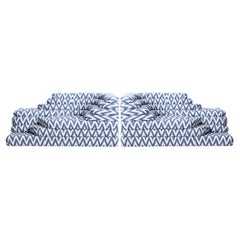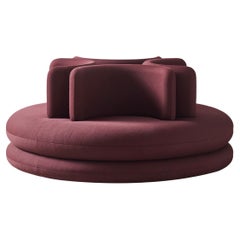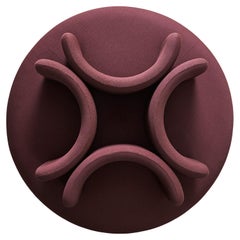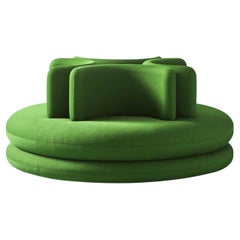Want more images or videos?
Request additional images or videos from the seller
1 of 13
Dino Gavina Pair of Blue Velvet 'Simone' Sofas for Studio Simon, 1971
$9,800List Priceper set
About the Item
- Creator:Dino Gavina (Designer),Studio Simon (Manufacturer)
- Dimensions:Height: 22.45 in (57 cm)Width: 84.26 in (214 cm)Depth: 31.5 in (80 cm)Seat Height: 15.75 in (40 cm)
- Sold As:Set of 2
- Style:Post-Modern (In the Style Of)
- Materials and Techniques:
- Place of Origin:
- Period:
- Date of Manufacture:1971
- Condition:Wear consistent with age and use. These sofas are in a good vintage condition with some minor marks on the lacquered shells - which is normal for a 50 year old lacquered surface. If you like to get these shells restored we can arrange that for you. Please let us know.
- Seller Location:Tilburg, NL
- Reference Number:1stDibs: LU5892225931102
About the Seller
5.0
Platinum Seller
Premium sellers with a 4.7+ rating and 24-hour response times
Established in 2020
1stDibs seller since 2021
208 sales on 1stDibs
Typical response time: 1 hour
Authenticity Guarantee
In the unlikely event there’s an issue with an item’s authenticity, contact us within 1 year for a full refund. DetailsMoney-Back Guarantee
If your item is not as described, is damaged in transit, or does not arrive, contact us within 7 days for a full refund. Details24-Hour Cancellation
You have a 24-hour grace period in which to reconsider your purchase, with no questions asked.Vetted Professional Sellers
Our world-class sellers must adhere to strict standards for service and quality, maintaining the integrity of our listings.Price-Match Guarantee
If you find that a seller listed the same item for a lower price elsewhere, we’ll match it.Trusted Global Delivery
Our best-in-class carrier network provides specialized shipping options worldwide, including custom delivery.You May Also Like
Sofa " Simone " by Dino Gavina for Studio Simon, Italy 1971
Located in Lot/Drogenbos, BE
Pair of Sofa two seats model “ Simone ” Structure in gloss black lacquered wood with velvet and linen fabric (new upholstery) Studio Simon 1971.
Designed by Dino Gavina and Kazuhide...
Category
Vintage 1970s Italian Sofas
Materials
Fabric, Wood
$9,094 / set
H 22.84 in W 61.82 in D 33.47 in
Studio Simon Black Wood and Azure Velvet Two-Seater “Simone” Sofa, Italy, 1975
By Studio Simon
Located in Vicenza, IT
Two-seater “Simone” sofa, designed and manufactured by Studio Simon in 1975.
The structure is made of black lacquered wood. An azure velvet big seat completes the sofa.
The min...
Category
Vintage 1970s Italian Mid-Century Modern Sofas
Materials
Cotton, Velvet, Foam
$4,755
H 20.48 in W 61.82 in D 31.89 in
Studio Simon Minimalist Black Leather Three-Seater “Simone” Sofa, Italy, 1975
By Studio Simon
Located in Vicenza, IT
Three-seater “Simone” sofa, designed and manufactured by Studio Simon in 1975.
The structure is made of black lacquered wood. A black leather big seat completes the sofa.
The minim...
Category
Vintage 1970s Italian Mid-Century Modern Sofas
Materials
Leather, Foam, Beech
$9,510
H 20.48 in W 82.68 in D 31.89 in
Carlo Scarpa Iroko Wood and Azure Velvet Cornaro Sofa for Studio Simon, 1974
By Studio Simon, Carlo Scarpa
Located in Vicenza, IT
Cornaro two-seater sofa, designed by Carlo Scarpa and manufactured by Studio Simon in 1974.
Made of Iroko wood, foam, and azure velvet by JAB.
Fully restored in Italy.
Born in Ven...
Category
Vintage 1970s Italian Mid-Century Modern Living Room Sets
Materials
Chenille, Velvet, Foam, Wood
$19,614
H 25.6 in W 86.62 in D 34.26 in
Carlo Scarpa Iroko Wood and Jacquard Velvet Cornaro Sofa for Studio Simon, 1974
By Carlo Scarpa, Studio Simon
Located in Vicenza, IT
Cornaro two-seater sofa, designed by Carlo Scarpa and manufactured by Studio Simon in 1974.
Made of Iroko wood, foam, and light blue jacquard velvet by Zimmer + Rohde.
Fully restor...
Category
Vintage 1970s Italian Mid-Century Modern Living Room Sets
Materials
Chenille, Velvet, Foam, Wood
$21,397
H 25.6 in W 86.62 in D 34.26 in
Lacquered 3-seater sofa and leather Studio Simon by Gavina
By Dino Gavina, Studio Simon
Located in Milano, MI
Elegant "Simone" Sofa Designed by Dino Gavina for Studio Simon in the 1970s.
Cushions upholstered in black leather and polyester lacquered wood frame, glossy black.
Sofa frame solid...
Category
Mid-20th Century Italian Mid-Century Modern Sofas
Materials
Leather, Wood
$7,379 Sale Price
35% Off
H 31.89 in W 82.68 in D 22.05 in
Dino Gavina for Studio Simon, Andy Warhol Campbell's Soup Stool, Italy 1971
By Studio Simon, Dino Gavina
Located in Naples, IT
Rare Campbell' Soup stool designed by Dino Gavina as a tribute to Andy Warhol in 1971 for the Simon company as part of the seminal Ultramobile Exhibition- Collection (1971). Dino Gav...
Category
Vintage 1970s Italian Mid-Century Modern Stools
Materials
Metal
$5,349
H 17.72 in Dm 11.82 in
Dino Gavina for Studio Simon, Andy Warhol Campbell's Soup Stool, Italy 1971
By Studio Simon, Dino Gavina
Located in Naples, IT
Rare Campbell' Soup stool designed by Dino Gavina as a tribute to Andy Warhol in 1971 for the Simon company as part of the seminal Ultramobile Exhibition- Collection (1971). Dino Gav...
Category
Vintage 1970s Italian Mid-Century Modern Stools
Materials
Metal
$5,349 / item
H 17.72 in Dm 11.82 in
Dino Gavina for Studio Simon, Andy Warhol Campbell’s Soup Can Stool, Italy, 1971
By Studio Simon, Dino Gavina
Located in London, GB
Rare Campbell's Soup stool /can designed by Dino Gavina as a tribute to Andy Warhol in 1971 for Simon Simon as part of the seminal Ultramobile Exhibition- Collection (1971).
Origina...
Category
Vintage 1970s Italian Mid-Century Modern Stools
Materials
Metal
$5,442
H 17.72 in Dm 12.6 in
Dino Gavina for Studio Simon, Andy Warhol Campbell’s Soup Can Stool, Italy, 1971
By Dino Gavina, Studio Simon
Located in London, GB
Rare Campbell's Soup stool /can designed by Dino Gavina as a tribute to Andy Warhol in 1971 for Simon Simon as part of the seminal Ultramobile Exhibition- Collection (1971).
Origina...
Category
Vintage 1970s Italian Mid-Century Modern Stools
Materials
Metal
$5,442
H 17.72 in Dm 12.6 in
More From This Seller
View AllUbald Klug Pair of 'Terrazza' Sofas Outdoor Version in Fabric for De Sede
By Ubald Klug
Located in Tilburg, NL
Ubald Klug Pair of DS-1025 'Terrazza' Sofas, Outdoor Version in Fabric Upholstery for De Sede, Switzerland. New, current production.
The timeless classic 'Terrazza' sofa by De Sede ...
Category
21st Century and Contemporary Swiss Mid-Century Modern Sofas
Materials
Fabric, Wood
Verner Panton 'Easy' Sofa for Verpan
By Verner Panton
Located in Tilburg, NL
Verner Panton 'Easy' sofa for Verpan. Designed in 1963. New, current production.
With its round shapes and layered design, the Easy collection stands out as one of the most visual...
Category
21st Century and Contemporary Danish Scandinavian Modern Sofas
Materials
Fabric
$9,615 / item
Verner Panton 'Easy' Sofa for Verpan
By Verner Panton
Located in Tilburg, NL
Verner Panton 'Easy' sofa for Verpan. Designed in 1963. New, current production.
With its round shapes and layered design, the Easy collection stands out as one of the most visually...
Category
21st Century and Contemporary Danish Scandinavian Modern Sofas
Materials
Fabric
$10,824 / item
Verner Panton 'Easy' Sofa for Verpan
By Verner Panton
Located in Tilburg, NL
Verner Panton 'Easy' sofa for Verpan. Designed in 1963. New, current production.
With its round shapes and layered design, the Easy collection stands out as one of the most visually...
Category
21st Century and Contemporary Danish Scandinavian Modern Sofas
Materials
Fabric
$11,598 / item
Verner Panton Cloverleaf Sofa 5 Sections for Verpan
Located in Tilburg, NL
Verner Panton cloverleaf sectional sofa. Current production. This listing shows a 5-piece Cloverleaf Sofa. Seats at least 9 people in a very interestin...
Category
21st Century and Contemporary Sofas
Materials
Fabric
Roberto Menghi 'Hall' Sofa for Arflex 1958
By Roberto Menghi
Located in Tilburg, NL
Roberto Menghi 'Hall' Sofa for Arflex, designed in 1958. Italy.
New, current production. Price noted is for a sofa upholstered in fabric group T6.
We are at the end of the ‘50s: ...
Category
21st Century and Contemporary Italian Mid-Century Modern Sofas
Materials
Steel
$6,270 / item
Recently Viewed
View AllMore Ways To Browse
Simon International
Velvet Sofa Pair
Bastiano Sofa By Tobia Scarpa For Knoll
Dino Gavina Simon Studio
Fifties Sixties Seventies
Kazuhide Takahama Sofa For Knoll
Pier Magistretti
Leather Sofa Adjustable
Mark Humphrey
Paloma Sofa
Patchwork Couch
Patchwork Sofas
Perriand Tokyo
Rattan Two Seater
Togo Seat
Vintage 2 Seater Sofa
Vintage Bamboo Furniture Sofa
Wood Arm Sofa



